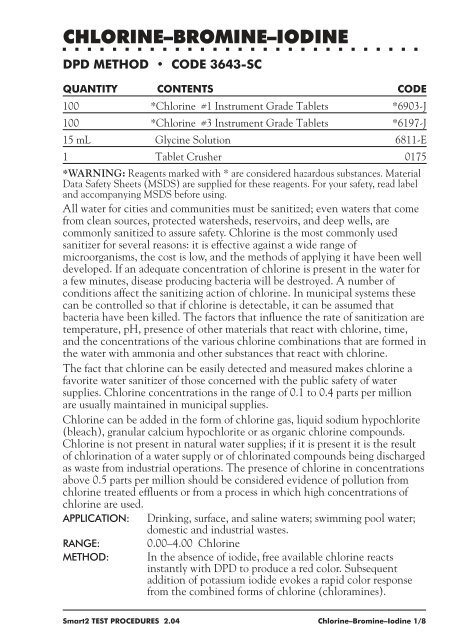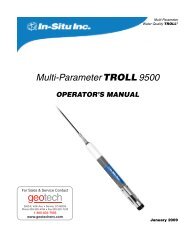TEST INSTRUCTIONS - Geotech Environmental Equipment
TEST INSTRUCTIONS - Geotech Environmental Equipment
TEST INSTRUCTIONS - Geotech Environmental Equipment
You also want an ePaper? Increase the reach of your titles
YUMPU automatically turns print PDFs into web optimized ePapers that Google loves.
CHLORINE–BROMINE–IODINE<br />
DPD METHOD CODE 3643-SC<br />
QUANTITY CONTENTS CODE<br />
100 *Chlorine #1 Instrument Grade Tablets *6903-J<br />
100 *Chlorine #3 Instrument Grade Tablets *6197-J<br />
15 mL Glycine Solution 6811-E<br />
1 Tablet Crusher 0175<br />
*WARNING: Reagents marked with * are considered hazardous substances. Material<br />
Data Safety Sheets (MSDS) are supplied for these reagents. For your safety, read label<br />
and accompanying MSDS before using.<br />
All water for cities and communities must be sanitized; even waters that come<br />
from clean sources, protected watersheds, reservoirs, and deep wells, are<br />
commonly sanitized to assure safety. Chlorine is the most commonly used<br />
sanitizer for several reasons: it is effective against a wide range of<br />
microorganisms, the cost is low, and the methods of applying it have been well<br />
developed. If an adequate concentration of chlorine is present in the water for<br />
a few minutes, disease producing bacteria will be destroyed. A number of<br />
conditions affect the sanitizing action of chlorine. In municipal systems these<br />
can be controlled so that if chlorine is detectable, it can be assumed that<br />
bacteria have been killed. The factors that influence the rate of sanitization are<br />
temperature, pH, presence of other materials that react with chlorine, time,<br />
and the concentrations of the various chlorine combinations that are formed in<br />
the water with ammonia and other substances that react with chlorine.<br />
The fact that chlorine can be easily detected and measured makes chlorine a<br />
favorite water sanitizer of those concerned with the public safety of water<br />
supplies. Chlorine concentrations in the range of 0.1 to 0.4 parts per million<br />
are usually maintained in municipal supplies.<br />
Chlorine can be added in the form of chlorine gas, liquid sodium hypochlorite<br />
(bleach), granular calcium hypochlorite or as organic chlorine compounds.<br />
Chlorine is not present in natural water supplies; if it is present it is the result<br />
of chlorination of a water supply or of chlorinated compounds being discharged<br />
as waste from industrial operations. The presence of chlorine in concentrations<br />
above 0.5 parts per million should be considered evidence of pollution from<br />
chlorine treated effluents or from a process in which high concentrations of<br />
chlorine are used.<br />
APPLICATION: Drinking, surface, and saline waters; swimming pool water;<br />
domestic and industrial wastes.<br />
RANGE: 0.00–4.00 Chlorine<br />
METHOD: In the absence of iodide, free available chlorine reacts<br />
instantly with DPD to produce a red color. Subsequent<br />
addition of potassium iodide evokes a rapid color response<br />
from the combined forms of chlorine (chloramines).<br />
Smart2 <strong>TEST</strong> PROCEDURES 2.04 Chlorine–Bromine–Iodine 1/8

















